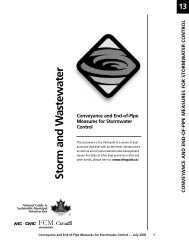The State of Canada's Cities and Communities 2012 - FCM
The State of Canada's Cities and Communities 2012 - FCM
The State of Canada's Cities and Communities 2012 - FCM
You also want an ePaper? Increase the reach of your titles
YUMPU automatically turns print PDFs into web optimized ePapers that Google loves.
Chapter 6<br />
Page 2<br />
Approximately 34 million tonnes <strong>of</strong> solid waste<br />
is generated annually in Canada, or 1,031 kg <strong>of</strong><br />
waste per person per year. Since the 1990s, the<br />
country’s diversion rate has levelled <strong>of</strong>f at approximately<br />
25%—although some communities<br />
have managed diversion rates as high as 70%.<br />
Each year, local governments spend approximately<br />
$2.6 billion to manage waste, including<br />
$1.1 billion in collection <strong>and</strong> transportation costs,<br />
$465 million for operation <strong>of</strong> disposal facilities,<br />
<strong>and</strong> $368 million in tipping fees. This state <strong>of</strong><br />
affairs diverts dollars from municipal c<strong>of</strong>fers, <strong>and</strong><br />
locks Canada into a linear waste-management<br />
model—from producer to consumer to l<strong>and</strong>fill.<br />
It is a significant waste <strong>of</strong> potential secondary<br />
resources, including energy. Biodegradable materials<br />
make up the greatest proportion <strong>of</strong> this<br />
model: approximately 22.1 million tonnes. <strong>The</strong>se<br />
decompose to generate methane gas, at close<br />
to 13.2 million tonnes <strong>of</strong> CO 2 e per year.<br />
<strong>The</strong> average person rarely makes the link between<br />
solid waste, energy <strong>and</strong> climate change.<br />
A growing number <strong>of</strong> communities do, however,<br />
<strong>and</strong> are exploring ways <strong>of</strong> transforming waste<br />
into resources through diversion <strong>of</strong> organic<br />
materials <strong>and</strong> energy production. <strong>FCM</strong>’s research<br />
suggests that a total <strong>of</strong> 66 L<strong>and</strong>fill Gas <strong>and</strong><br />
Capture (LFG&C) projects were operational<br />
in Canada in 2007, 1 38 <strong>of</strong> which were flaring<br />
projects, <strong>and</strong> 28 <strong>of</strong> which utilized LFG to either<br />
1 Environment Canada’s National Inventory <strong>of</strong> L<strong>and</strong>fill Projects (Environment Canada, 2010).<br />
generate electricity or heat. As indicated<br />
in Table 1, total annual emission reductions<br />
from these projects were estimated to be<br />
6.9 megatonnes <strong>of</strong> GHG emissions in 2007.<br />
TABLE 1: EMISSION REDUCTIONS BY PROJECT<br />
TYPE IN 2007<br />
Project Type Number <strong>of</strong> Current CO 2 e<br />
Existing LFG&C Reductions<br />
Projects (tonnes /yr)<br />
Flare 38 2,317,000<br />
Electricity 17 3,120,000<br />
Direct Use 9 1,174,000<br />
Combination 2 351,000<br />
TOTAL 66 6,963,000<br />
A 2010 review conducted by EnviroEconomics<br />
found that a total <strong>of</strong> 136 l<strong>and</strong>fills across Canada<br />
had some potential to reduce emissions. <strong>The</strong>se<br />
l<strong>and</strong>fills currently receive 90% <strong>of</strong> Canada’s municipal<br />
solid waste. Table 2 identifies project type<br />
for the 136 l<strong>and</strong>fills included in the inventory, as<br />
well as current GHG emission reductions <strong>and</strong><br />
an estimate <strong>of</strong> additional potential GHG emission<br />
reductions. <strong>The</strong> research found that 40% <strong>of</strong><br />
existing <strong>and</strong> developing projects were geared<br />
towards energy production.<br />
TABLE 2: INVENTORY LANDFILL PROJECT TYPES AND POTENTIAL EMISSION REDUCTIONS<br />
Project Type Number <strong>of</strong> LFG Current CO 2 e Additional<br />
L<strong>and</strong>fills Production Reductions Potential CO 2 e<br />
Reductions<br />
(scfm) 1 (tonnes /yr) (tonnes /yr)<br />
Existing LFG&C Project 66 106,000 6,963,000 3,032,000<br />
Developing 11 14,100 - 914,000<br />
C<strong>and</strong>idate 34 30,700 - 1,939,000<br />
Lower Potential 25 4,900 - 352,000<br />
TOTAL 136 155,000 6,963,000 6,237,000<br />
1 SCFM IS THE ESTIMATED TOTAL FLOW RATE OF LFG THAT IS GENERATED AT THE LANDFILL SITE IN STANDARD CUBIC FEET PER MINUTE.<br />
LFG FLOW RATES TYPICALLY PEAK AT LANDFILLS SEVERAL YEARS AFTER CLOSURE, THEN DECLINE OVER THE NEXT 15 TO 30 YEARS,<br />
DEPENDING ON THE RATE OF DECAY FOR ORGANIC WASTES.

















